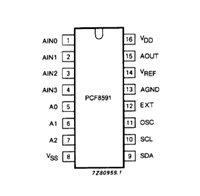AD671
The last transition (from 1111 1111 1110 to 1111 1111 1111)
should occur for an analog value 1 1/2 LSB below the nominal
full scale (9.9963 volts for 10.000 volts full scale). The gain er-
ror is the deviation of the actual level at the last transition from
the ideal level. The gain error can be adjusted to zero as shown
in Figures 7, 8 and 9.
Integral nonlinearity refers to the deviation of each individual
code from a line drawn from “zero” through “full scale.” The
point used as “zero” occurs 1/2 LSB (1.22 mV for a 10 V span)
before the first code transition (all zeros to only the LSB on).
“Full scale” is defined as a level 1 1/2 LSB beyond the last code
transition (to all ones). The deviation is measured from the low
side transition of each particular code to the true straight line.
The temperature coefficients for unipolar offset, bipolar zero
and gain error specify the maximum change from the initial
(+25°C) value to the value at TMIN or TMAX
.
An ideal ADC exhibits code transitions that are exactly 1 LSB
apart. DNL is the deviation from this ideal value. Thus every
code must have a finite width. Guaranteed no missing codes to
10-bit resolution indicates that all 1024 codes represented by
Bits 1–10 must be present over all operating ranges. Guaranteed
no missing codes to 11- or 12-bit resolution indicates that all
2048 and 4096 codes, respectively, must be present over all op-
erating ranges.
The only effect of power supply error on the performance of the
device will be a small change in gain. The specifications show
the maximum full-scale change from the initial value with the
supplies at the various limits.
S/N+D is the ratio of the rms value of the measured input signal
to the rms sum of all other spectral components, including har-
monics but excluding dc. The value for S/N+D is expressed in
decibels.
The first transition should occur at a level 1/2 LSB above analog
common. Unipolar offset is defined as the deviation of the ac-
tual from that point. This offset can be adjusted as discussed
later. The unipolar offset temperature coefficient specifies the
maximum change of the transition point over temperature, with
or without external adjustments.
ENOB is calculated from the expression SNR = 6.02N +
1.8 dB, where N is equal to the effective number of bits.
THD is the ratio of the rms sum of the first six harmonic com-
ponents to the rms value of the measured input signal and is ex-
pressed as a percentage or in decibels.
In the bipolar mode the major carry transition (0111 1111 1111
to 1000 0000 0000) should occur for an analog value 1/2 LSB
below analog common. The bipolar offset error and temperature
coefficient specify the initial deviation and maximum change in
the error over temperature.
The peak spurious or peak harmonic component is the largest
spectral component excluding the input signal and dc. This
value is expressed in decibels relative to the rms value of a full-
scale input signal.
Theory of Operation
The AD671 uses a successive subranging architecture. The ana-
log to digital conversion takes place in four independent steps or
flashes. The analog input signal is subranged to an intermediate
residue voltage for the final 12-bit result by utilizing multiple
flashes with subtraction DACs (see the AD671 functional block
diagram).
(AD671-500) and less than 50 ns after the falling edge of
ENCODE (AD671–750) or after the falling edge of DAV. The
time window prevents digitally coupled noise from being intro-
duced during the final stages of conversion. An internal timing
generator circuit accurately controls all internal timing.
ACOM
22
The AD671 can be configured to operate with unipolar (0 V to
+5 V, 0 V to +10 V) or bipolar (±5 V) inputs by connecting
AIN (Pin 20), REFIN (Pin 19) and BPO/UPO (Pin 21) as
shown in Figure 2.
BPO/UPO
21
BPO/UPO 21
BPO/UPO 21
AIN
AIN 20
20
19
20
AIN
AIN
AIN
AIN
The AD671 conversion cycle begins by simply providing an ac-
tive HIGH pulse on the ENCODE pin (Pin 16). The rising
edge of the ENCODE pulse starts the conversion. The falling
edge of the ENCODE pulse is specified to operate within a win-
dow of time: less than 30 ns after the rising edge of ENCODE
19
REF IN
REF IN
19
+
REF IN
–
+
5V REF
+
5V REF
+
5V REF
+
+
0 TO 10V
0 TO 5V
5V TO 5V
Figure 2. Input Range Connections
REV. B
–7–






 STM32F030C6芯片介绍:主要参数分析、引脚配置说明、功耗及封装
STM32F030C6芯片介绍:主要参数分析、引脚配置说明、功耗及封装

 PCF8591数据手册解读:参数、引脚说明
PCF8591数据手册解读:参数、引脚说明

 一文带你了解ss8050参数、引脚配置、应用指南
一文带你了解ss8050参数、引脚配置、应用指南

 深入解析AD7606高性能多通道模数转换器:资料手册参数分析
深入解析AD7606高性能多通道模数转换器:资料手册参数分析
